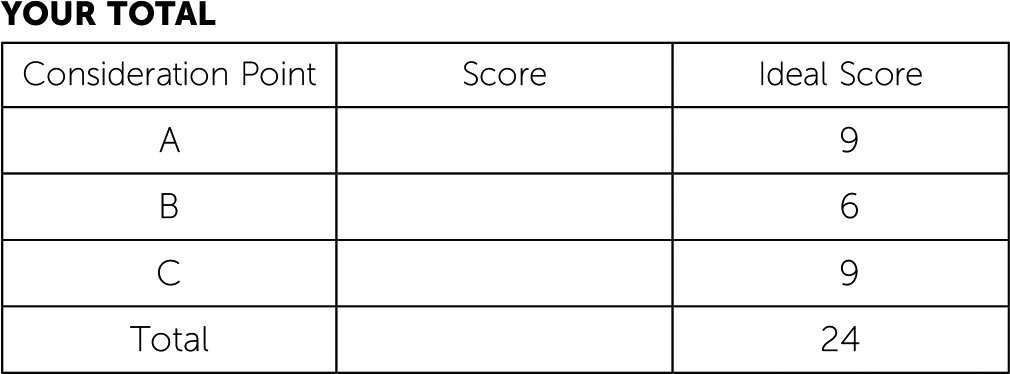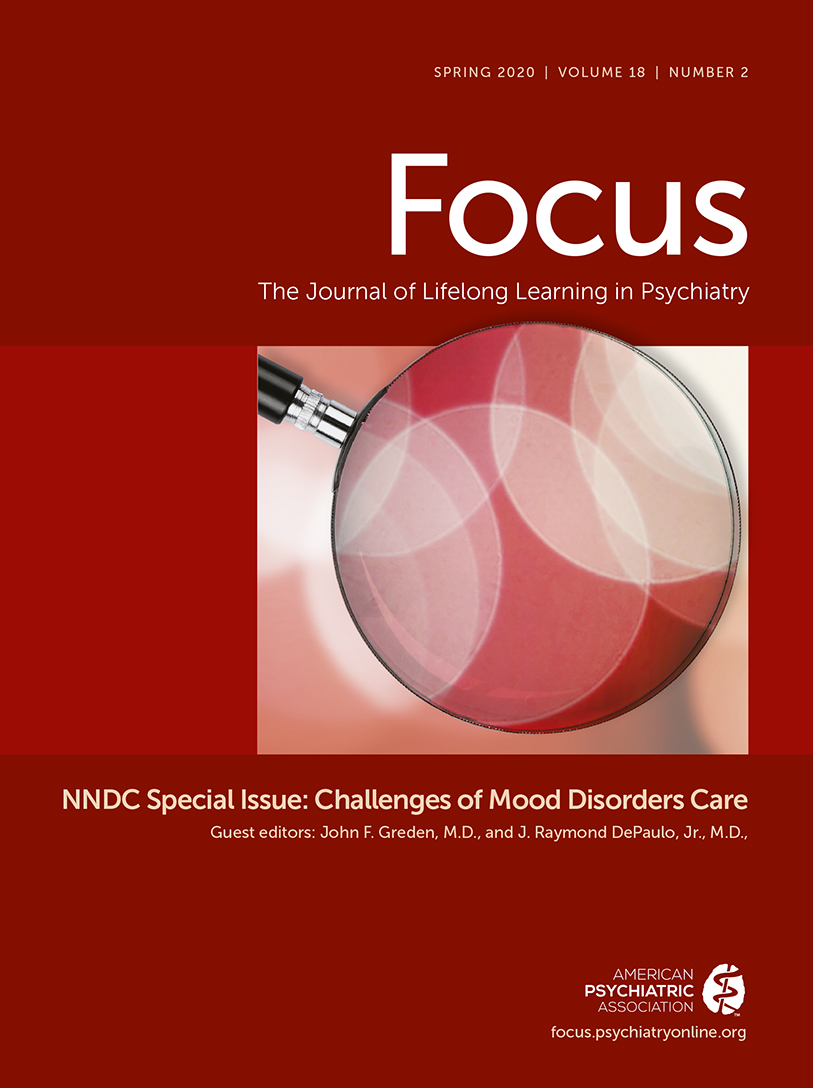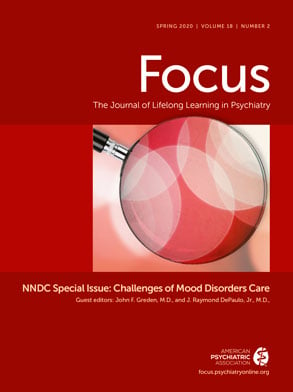This exercise is designed to test your comprehension of material relevant to this issue of Focus as well as your ability to evaluate, diagnose, and manage clinical problems. Answer the questions below to the best of your ability with the information provided, making your decisions as if the individual were one of your patients.
Questions are presented at “consideration points” that follow a section providing information about the case. One or more choices may be correct for each question; base your choices on your clinical knowledge and the history provided. Read all options for each question before making any selections. You are given points on a scale graded for the best possible answer(s), and points are deducted for answers that would result in a poor outcome or delay your arrival at the right answer. Answers that have little or no impact receive zero points. At the end of the exercise, you will add up your points to obtain a total score.
This exercise describes the evaluation and treatment of a patient who is experiencing recurrence of major depression soon after giving birth to her first child. Questions and answers examine the use of several approaches to managing her depressive episode.
Case Vignette
You are called by an obstetrician-gynecologist (OB-GYN) colleague for urgent consultation on one of her patients, Rebecca, who has recently given birth. Rebecca is a 32-year-old woman who has had two prior episodes of major depression and has been engaged in interpersonal psychotherapy (IPT) with a local psychologist during her pregnancy. Despite this therapy, she is now quite symptomatic; your OB-GYN colleague told you that her score on the nine-item Patient Health Questionnaire was 18. Fortunately, you had an opening in your schedule that afternoon and agreed to see the patient in your office.
When Rebecca arrived, she offered additional history. She reported that she had not taken any antidepressants since her previous bout of depression, with her last dose more than a year ago. Expanding on what you had been told by her OB-GYN, she had started IPT soon after she became pregnant because her mother had experienced postpartum depression after the birth of her older sister and again after the patient’s birth as well, and Rebecca was worried about her own situation. She and her husband had long discussions with the OB-GYN about the use of antidepressant medication during pregnancy, and they wanted to minimize all in utero exposures; after delivery, she has been breastfeeding her newborn daughter and again was not enthusiastic about starting pharmacotherapy.
After she and her daughter returned home from the hospital, the patient’s sleep-wake cycle had become profoundly disrupted, seldom getting more than 2 hours of uninterrupted sleep. Her husband had taken paternity leave and was at home to support her and their daughter, but the patient did not have much success in pumping breast milk so that her husband could handle some of the feedings. Her chief complaint was that she felt markedly sad and guilty about her perceived failings as a mother and that she would “screw up” her daughter much as she felt her mother’s disengagement during her own infancy had left her “a mess.” These ruminations brought her to tears many times each day. She had lost her appetite and had lost more weight than her OB-GYN considered safe, but she had lost interest in even her favorite foods. She felt fatigued all the time but dismissed this weariness, saying “who wouldn’t without sleep?” She experienced considerable anxiety much of the day and had become reluctant to leave the house “because everyone will be judging me and see that I’m the world’s worst mother.” She denied any thoughts of harming herself, the baby, or anyone else, saying “I’m depressed, but I’m no Andrea Yates.”
She reported she had experienced a bout of depression during college (age 20). This episode was in the wake of a romantic break-up, and she received some sort of weekly therapy at the college’s counseling center for about 8 weeks. She finished college with honors and had been well until age 27. She had moved into town to take a new job in a start-up company, but she had some difficulties adapting both to life in a city where she knew few people and to the demands of supervising others at work for the first time. She was prescribed a selective serotonin reuptake inhibitor by her OB-GYN physician (her primary care physician) and responded well, with her depression remitting within 12 weeks of treatment. In parallel, she also had a course of cognitive-behavioral therapy that she found helpful. After 8 months of feeling well, she was tapered off that agent. She had not taken any antidepressant agents for more than a year and had been doing well with weekly IPT sessions during the pregnancy and for the first 2 weeks after delivery, when symptoms returned.
The patient reported that, in addition to the recurrent depressions her mother had experienced, she has a maternal uncle with bipolar disorder, a cousin with alcohol dependence, and a great uncle who ended his life via suicide with a self-inflicted shotgun injury.
Aside from postpartum depression, the patient’s pregnancy had been unremarkable. The patient gave you permission to speak with family members to collect collateral history.
Consideration Point A
Using what you know of the patient’s history at this point, what information would you prioritize in speaking with the patient’s family for clarification?
A.1 Any history suggestive of hypomania or mania
A.2 Any history suggestive of delusions or hallucinations
A.3 Any history suggestive of past drug use
A.4 Any history suggestive of attention-deficit hyperactivity disorder
A.5 Any history suggestive of posttraumatic stress disorder
Case Vignette Continues
Before calling any relatives, you examined the patient carefully. She was pleasant and cooperative but was markedly depleted of energy and made very poor eye contact. Her hair was unkempt and unwashed, and she wore sweatpants and an oversize sweatshirt encrusted with dried food. No psychomotor agitation was noted, and her low energy was manifest with mild psychomotor slowing. Speech was of a somewhat slowed rate and monotonous prosody but with normal volume. Affect was flat and somewhat labile, in that she became tearful at times. She characterized her mood “about as depressed as I think I’ve ever been.” Her thought process was slowed but without loosening of association, nonlinearity, or a preoccupation with specific ideas of reference and delusional beliefs. Her thought content was free of suicidal or homicidal ideation, but she was focused on a belief that she was the “worst mother ever.”
Cognitively, she was awake, alert, and oriented to person and place; however, she was off on the date by a few days. Memory registration was intact with three out of three stimuli, and recall after delay was two out of three items. She was able to spell the word “world” forward and backward accurately, albeit slowly. She had no difficulty repeating the phrase “no ifs, ands, or buts.” Her insight and judgment were adequate in that she recognized that she was having another bout of major depression and she needed help. No tremors or involuntary movements were noted. Station was stable without sway, and gait was marked by normal stride length and arm swing.
Phone calls with the patient’s husband and her sister revealed that the patient had no history, either remote or recent, to suggest bipolar disorder, psychosis, substance use disorders, attention-deficit hyperactivity disorder, or posttraumatic stress disorder. They confirmed that she had been doing well until very recently.
The patient’s husband described that the patient had been very concerned about taking any medications during pregnancy “based on things she had read online.” She had never used tobacco products and had abstained from all alcohol consumption and over-the-counter medications for 3 months before she became pregnant, “when we started trying in earnest to have children.”
Consideration Point B
After a discussion with the patient’s referring OB-GYN, you suggested to the patient that she might pursue which of the following interventions?
B.1 Ketamine intravenously at a subanesthetic dose
B.2 Tranylcypromine orally
B.3 Brexanolone intravenously
B.4 Transcranial magnetic stimulation (TMS) therapy
Case Vignette Continues
Despite reviewing the scientific literature on these treatments with the patient and her husband, the patient rejected the medication options you had presented to her because she was determined to continue to breastfeed and found that the “pump and dump” strategy was unacceptable for minimizing exposure.
Consideration Point C
What other nonpharmacologic interventions have evidence to support their use among patients with depression (not necessarily in the postpartum period)?
C.1 Electroconvulsive therapy
C.2 Psychodynamic psychotherapy
C.3 Bright light phototherapy in the evening
C.4 Online-delivered cognitive-behavioral therapy
Case Vignette Concludes
In discussing nonpharmacologic options with the patient, you mentioned electroconvulsive therapy as well as transcranial magnetic stimulation (TMS), and she voiced a strong preference for the latter, even though it may take longer to get symptom relief, “because I’ll tough it out so that I can remember my early months with my daughter.”
She was able to be scheduled to start TMS rapidly, and she began to feel some improvement in mood and other symptoms between treatments 10 and 15. Her depression was in remission by treatment 30, and she completed her insurance-approved course of 36 treatment sessions. The biggest obstacles to receiving TMS, after her insurance company had agreed to provide coverage, were logistical, in terms of having someone take care of the baby while the patient was getting her TMS treatments and of getting out of the house for a doctor’s appointment every weekday for many weeks.
At 1-year follow-up, Rebecca and her daughter had formed a close bond, and her depression was still in remission.
Answers: Scoring, Relative Weights, and Comments
Consideration Point A
A.1 (
+3)
Any history suggestive of hypomania or mania. The patient acutely had exhibited no signs of elevated mood and neurovegetative activation consistent with the
DSM-5 criteria for a hypomanic or manic episode in bipolar disorder, but any past history suggestive of bipolar disorder would support consideration of a mood stabilizer agent and something to address depression specifically (
1).
A.2 (
+3)
Any history suggestive of delusions or hallucinations. Past delusions or hallucinations would raise concern about covert psychotic symptoms in the present, which may influence treatment choice (
1).
A.3 (
+3)
Any history suggestive of past drug use. Past use of several types of drugs can leave a person with symptoms overlapping with major depressive disorder and may call for different treatment strategies (
1).
A.4 (
0)
Any history suggestive of attention-deficit hyperactivity disorder. There were no features suggestive of attention-deficit hyperactivity disorder (
1).
A.5 (
0)
Any history suggestive of posttraumatic stress disorder. Although depression is often co-occurring among patients with posttraumatic stress disorder, the patient’s presentation does not include symptoms suggestive of posttraumatic stress disorder or acute stress disorder (
1).
Consideration Point B
B.1 (
−3)
Ketamine intravenously at a subanesthetic dose. Ketamine has been studied as a treatment for depression, and esketamine has been approved by the U.S. Food and Drug Administration (FDA) as an antidepressant (
2); however, there is little information about its passage into breast milk (
3).
B.2 (
−3)
Tranylcypromine orally. The monoamine oxidase inhibitor tranylcypromine can be useful for managing pharmacoresistant depression (
4), but it has been found in breast milk (
3).
B.3 (
+3)
Brexanolone intravenously. This neurosteroid has been approved by the FDA for use as a treatment for postpartum depression via intravenous infusion (
5), and very little is present in breast milk (
3).
B.4 (
+3)
Transcranial magnetic stimulation (TMS) therapy. TMS has been reported to be an effective and safe treatment for depression in the peripartum period (
6–
8).
Consideration Point C
C.1 (
+3)
Electroconvulsive therapy. This intervention has long-standing evidence for treating depression when other treatments have fallen short (
4).
C.2 (
+3)
Psychodynamic psychotherapy. This psychotherapeutic approach has been shown to be efficacious (
4).
C.3 (
0)
Bright light phototherapy in the evening. Bright light therapy can be helpful but needs to be administered in the morning (
9).
C.4 (
+3)
Online-delivered cognitive-behavioral therapy. Meta-analytic work suggests that cognitive-behavioral therapy delivered online may have efficacy similar to treatment delivered in person (
10).


